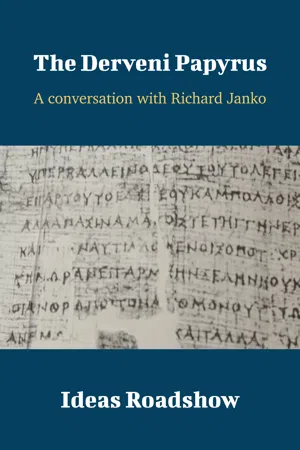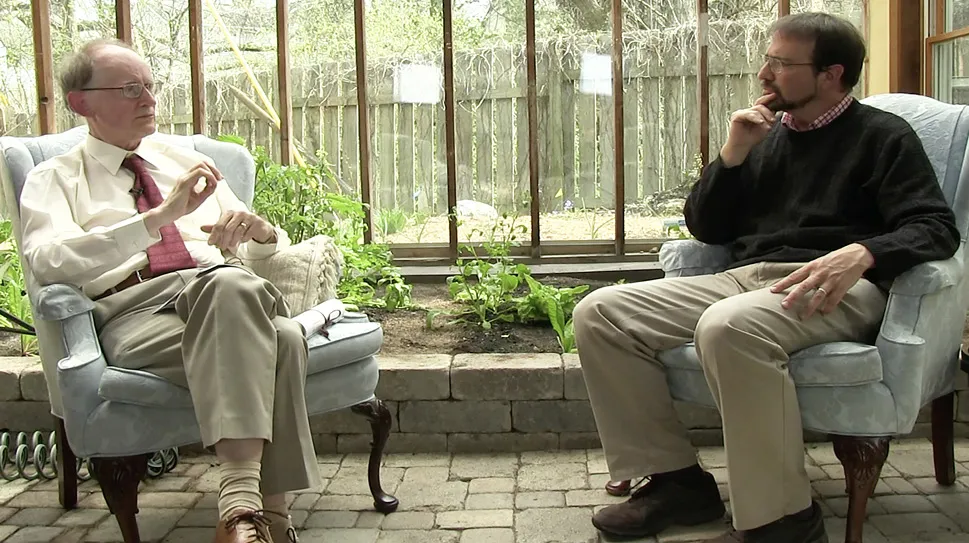![]()
The Conversation
![]()
I. A Great Discovery
Followed by unparalleled foot-dragging
HB: I’d like to talk about the fascinating story of the Derveni papyrus, which not too long ago I had never heard of. You have your own intriguing views about the contents of the papyrus, but before we get there we should first talk about what this thing actually is.
RJ: Well, I’m happy to do that. This is the oldest European book that survives in its own physical form.
HB: Is there an older non-European book?
RJ: Yes, a lot of books from Egypt survive on papyrus, from as far back as 2400 BCE. But this is the oldest one found in Europe. It was discovered in January of 1962 in Derveni, Greece, by a Greek archaeologist, Petros Themelis, who was excavating a funeral pyre in northern Greece near Thessaloniki. The scroll had been on the funeral pyre. It was half-burned and had just rolled off to one side. When they dug it up they thought it was a stick because it was black like a piece of coal. Somehow or other, to his eternal credit, Petros Themelis recognized that it had writing on the inside, making it the oldest surviving book on papyrus found in Europe.
HB: It must have been very brittle as well, I’m thinking. I assume that you can’t just pick these things up. Once he realized what it was, what did he do?
RJ: Well, presumably he tried to touch it as little as possible. Papyrus is the ancient writing material, the equivalent of paper. It’s a very tall reed that grows in the Nile.
It grows these tall fronds, and they cut the stocks and hammer them together in two layers to make a kind of paper. When it’s burned, it becomes like a potato chip, really: it’s so brittle that you can’t bend it without breaking it. But it’s unlike a potato chip in that it’s around a tenth of a millimetre thick, so it’s very thin indeed—it’s like burnt newspaper.
When they got this out of the ground, they contacted the only person in the world who then knew how to deal with these things—an Austrian called Anton Fackelmann.
Fackelmann went to Thessaloniki and by using papyrus juice and static electricity he managed to separate the layers. He mounted them on paper—which we probably wouldn’t do now—and laid them out in the order they came off. The papyrus was split into two halves down the middle; and it came off as stacks of fragments. He lifted one layer off after another and put them in order on the paper in frames.
They’re in a museum now in Thessaloniki and you can see them as sequences of fragments. They aren’t actually next to each other, because they’re successive circumferences from half of the papyrus all the time. So it has not physically been reconstructed: it’s become 200 fragments.
HB: Just getting back to this idea of papyrus juice and static electricity for a moment: how did he actually do that?
RJ: I don’t know. I wasn’t there and I’ve never seen it done.
HB: And how did he know to do that? Had he been doing that sort of thing before?
RJ: Yes, he worked on the burned papyri from Herculaneum and he had separated quite a few of those; the layers of the Herculaneum papyri were stuck together much more firmly than they were in this case. This was a relatively easy papyrus to do compared with Herculaneum.
HB: It just seems like such a bizarre technique. I wonder how many of these you have to go through until you get it right.
RJ: I don’t know how he did it. It’s quite astonishing that a way was found to conserve this material.
HB: And half of it is burned off, right?
RJ: Yes. The bottom part of the papyrus is burned off, so you’ve only got the top 16 lines of every column of writing. It’s a scroll, written in continuous columns. The “book”, as we know it, hadn’t been invented yet, and wouldn’t be for another 500-600 years or so.
HB: Right. So then what happened?
RJ: Well, Fackelmann did this; and then a Greek philologist called Kapsomenos published the end of the text in 1964. And everyone was very excited because this was a commentary by an early philosopher or scientist on a poem ascribed to the mythical singer Orpheus. This was a very mysterious text at the time—in 1964.
Then there was a long pause until 1982 when an unauthorized edition came out, in the back of a scholarly journal on unnumbered pages, which gave the text of the whole papyrus in some early form. Nobody quite knows who did that text or how it came about.
HB: Really? A bootleg copy?
RJ: Well, there was a leak because people got impatient. This thing was clearly going to be very important, and there was great distress that it still hadn’t come out.
HB: OK, so 20 years after the original discovery there still hadn’t been an authorized translation. Actually, I’m not sure I even know what “unauthorized” means in this context. Maybe you could tell me a bit about that.
RJ: Well, normally the people who are entrusted with publishing a papyrus publish it. This thing is not enormously long: my translation that I have here amounts to not even 8 whole pages, single-spaced. It is not an enormous text. Obviously it was going to be very hard to put it together out of 200 fragments, many of which are very small. But people were anxious to see this thing.
HB: Sure. If I’m a scholar in 1982 who’s not one of the people working on this, my question would surely have been, What’s taking you guys so long to come out with this? So what would have been the response to that question, you think?
RJ: Well, I suppose the response was, “We want to get it right”. But the best can be the enemy of the good. There are people who are perfectionists, quite reasonably, and want to produce the perfect text. Maybe that’s what happened.
At any rate, then the authors wrote in reply to this leaked publication—they were very unhappy that it had come out—saying, “We’ll bring it out in 1984”.
And then in 1993—notice the date—a conference was organized in Princeton where more of it came out. The editors were persuaded to contribute a text of the first seven columns, and they vetted a translation of the remainder, in the light of what they could see on the original. So that was another step.
And when that book came out is when I got interested in this, although I did once hear a lecture about it in Cambridge from Martin West, a very great classical scholar, back in 1978. He was speaking about the fragments of the poem, and he had a text of it back then—I still have the handout from that talk.
He allegedly...

